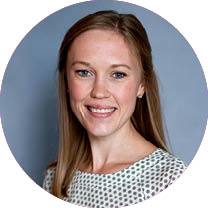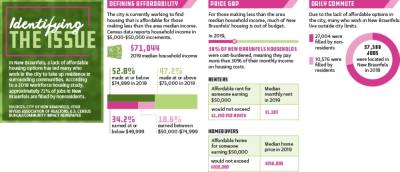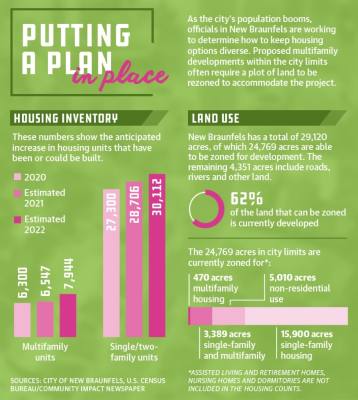Developers have prioritized communities aimed at adding multifamily housing to the local real estate market. However, some residents are concerned the projects will only add to existing traffic and density issues as the population of New Braunfels has increased by 47% over the past five years, according to census data.
In 2018, the city of New Braunfels worked with local entities and citizens to develop the Envision New Braunfels comprehensive plan that outlined goals to increase the diversity of housing options in New Braunfels to create more affordable options for those who work in the city, said Alice Jewell, CEO of the McKenna Foundation in New Braunfels.
“Housing is one of the cornerstones of people’s ability to thrive and even survive,” Alice Jewell said. “But we have come to realize that there [are] a lot of different opinions about housing. ... It conjures up a lot of emotion in people.”
City seeks to diversify housing
In 2018, the New Braunfels Economic Development Corp. hired Community Development Strategies to conduct a workforce housing study. The study revealed that one-third of households in New Braunfels were cost-burdened based on data gathered in 2017. The United States Department of Housing and Urban Development defines cost-burdened as families that spend more than 30% of their annual or monthly gross income on housing.
“[The study] was really the first time in print that everybody was able to realize what we’ve all known,” Alice Jewell said. “We all knew it, but now it was documented and legitimate.”
Approximately 22% of owner-occupied households were cost-burdened, and 48% of renter households were cost-burdened in 2017, according to the study.
In 2019 the city created the Workforce Housing Advisory Committee to assist city staff in developing plans to bring more affordable options to New Braunfels through changing zoning regulations, educating the public and identifying incentives for developers to build affordable options. As the city has grown and single-family homes now dominate the market, Jeff Jewell, economic and community development director for the city of New Braunfels, said the number of cost-burdened households has likely increased.
“You have a lot of supply being put on the ground today, but it’s being priced at such a point that is further and further out of reach for a larger and larger portion of the New Braunfels population,” Jeff Jewell said. “The way that you begin to address that is you start to put more housing in there.”
Building homes at a variety of price points would allow mobility within the community as families and individuals who cannot afford the majority of homes on the market in New Braunfels would be able to purchase a house within their budget, he said.
Though the demand for affordable options is high, developers have little incentive to build residential properties that may not produce enough revenue to repay loans used to construct them, Jeff Jewell said. Incentives such as fee waivers for homes constructed at or below $225,000, federal grants, state funding and other programs are necessary to make such projects affordable for developers, he said.
“A lot of our work has been focused on what regulatory tweaks can we be making to increase the supply of housing,” he said. “It is about how do you mold the built environment and your land-use rules to achieve the vision that’s outlined in Envision New Braunfels [comprehensive plan].”
Several new developments within city limits and in the extraterritorial jurisdiction of New Braunfels are expected to add many new residences over the next 20 years.
The 2,400-acre Veramendi project and the 1,880-acre Mayfair development will add thousands of new single-family homes, apartments and townhomes over the next 15-20 years.
Solms Landing, a 98-acre community located near Creekside Crossing, plans to add up to 215 single-family homes and 455 multifamily units in the next five to seven years.
“We’re running out of land in New Braunfels,” said Johnnie Rosenauer, a retired professor of real estate at several universities throughout Texas and a member of the WHAC. “We have to make very selective choices with the limited amount of open space that’s still available because the consequences will be far beyond this committee, or any of our lifetimes.”
Solutions to growth concerns
Even now, many who work in the city commute from surrounding areas because housing is not affordable or not available.
According to the workforce housing study, about 72% of the 37,580 jobs located in New Braunfels in 2017 were filled by nonresidents.
Stephen Brockman, vice president of leadership and small-business programs for The Greater New Braunfels Chamber of Commerce and at large member of the WHAC, said the daily outflow of residents and inflow of nonresidents for work contributes to traffic congestion throughout the area.
“We’re passing ourselves on the major roadways,” Brockman said. “You can follow the major arteries, I would say [I-]35 and [Hwy.] 46, figure out the communities along there and they’re coming in.”
However, some residents have voiced concerns that traffic might increase as additional housing is created and could add to other issues they believe have been brought on by the city’s rapid growth.
“Our roads are not adequate for existing traffic, let alone thousands more apartment residents,” said Timothy Davis, a resident and member of a local group called the Citizens of New Braunfels for Responsible Growth, during a June 14 City Council meeting. “The city needs to hire more staff, more police and more road department employees desperately.”
Members of the CNBRG regularly attend City Council meetings to oppose agenda items that are aimed at rezoning land to allow for multifamily projects that they believe would put strain on area infrastructure.
During the June 14 meeting, no council member made a motion to approve the first reading of an ordinance to rezone 49.5 acres of land located at 614 and 720 W. Zipp Road to allow for a mix of residential and nonresidential development. The item died following citizen opposition.
City council members have approved several similar rezoning ordinances this year.
Residents of an adjacent neighborhood and members of the CNBRG opposed the construction of an apartment complex on the property. They raised concerns that the development would cause congestion on Walnut Avenue and detract from surrounding communities.
In a statement to Community Impact Newspaper members of the CNBRG wrote that they would like to see a pause on all rezoning that would allow for apartments to be constructed, though they do not oppose existing projects currently underway.
“We understand that the growth is going to happen, and it cannot be stopped altogether. We need to more carefully allocate places to shop, small neighborhood parks and more police at this time until the infrastructure can support the people and provide adequate services and safety,” Davis said June 14. “Once we go down this road, there is no turning back.”
At the city level, officials are currently re-examining the zoning and development codes to better accommodate diverse housing options, Jeff Jewell said.
New Braunfels’ zoning codes have not been significantly updated since 1987, he said, and many existing codes limit the ability of developers and investors to create unique housing options. Multifamily housing is most often perceived to mean multistory apartment buildings, Brockman said, but other housing types exist that current zoning codes do not permit.
For example, Brockman said some developers have transformed existing homes into multi-unit residences to house more families at a lower cost.“If we let [developers] have a little bit of creative space, they could give us a bad product, or they could give us something amazing. And I tend to lean toward the market rewards the creativity and the innovation,” Brockman said. “So why wouldn’t we want to create an environment to make that thrive?”








